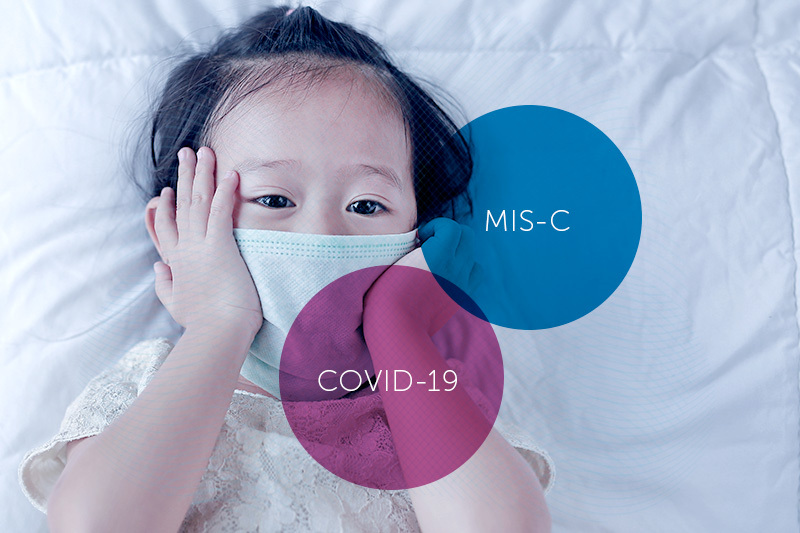Neurological involvement common in kids and teens with acute COVID-19 and MIS-C

In the largest study of its kind, researchers from Boston Children’s Hospital found neurological involvement in 22 percent of children and adolescents hospitalized with acute COVID-19 or multisystem inflammatory syndrome in children (MIS-C). These symptoms included fatigue, headache, confusion, difficulty walking or crawling, or loss of taste and smell. However, 1 in 8 children with neurological involvement developed life-threatening conditions including stroke, encephalitis, and Guillain-Barre syndrome.

“The good news is that the vast majority of young individuals with neurologic involvement had symptoms that were not very serious and did not linger,” says Kerri LaRovere, MD, neurologist at Boston Children’s and co-first author of the study, published in JAMA Neurology.
The study was part of the national Overcoming COVID-19 Public Health Surveillance Registry, funded by the Centers for Disease Control and Prevention and led by Adrienne Randolph, MD, MSc, a critical care physician at Boston Children’s. Another recent study described the key characteristics and differences in children and adolescents with COVID-19 and MIS-C from this cohort.
Type and severity of neurologic involvement varied
The study involved nearly 1,700 patients younger than 21 years of age hospitalized with either acute COVID-19 or MIS-C, a serious post-infectious condition. Of these, 365 patients — or 22 percent — had neurological symptoms or conditions. Similar numbers of patients with and without neurologic involvement had MIS-C, which suggests that MIS-C itself did not lead to a higher rate of neurologic involvement.
“The fact that nearly one-quarter of children and adolescents had neurological symptoms and conditions came as a bit of a surprise,” adds LaRovere. “It is not that much lower than the 36 percent rate of neurologic involvement found in studies among adults with COVID-19, and the range of neurologic problems was similar in children compared to adults.”


Although age and gender didn’t play a role in the development of neurologic involvement, the team noticed that the types of symptoms varied depending on age. For example, children younger than age 5 more commonly experienced seizures. Older children were more likely to experience lack of smell and taste, but researchers noted that may be because younger children are not able to recognize these symptoms.
Of note, a higher proportion of severe cases were found in Black and Latino patients. “It’s not clear yet why that is,” says Tina Young Poussaint, MD, FACR, neuroradiologist at Boston Children’s and one of the study’s authors. “We do not know if these children are more inclined to develop neurological involvement or if it is related to increased exposure to COVID-19.”
Pre-existing conditions were not the trigger
While one-quarter of children with neurologic involvement had a known pre-existing neurologic condition, the majority of children did not. “This study reminds us that previously healthy children can develop neurological complications, too, from COVID-19,” says LaRovere. “Clinicians should be aware of this possibility in any young individual who presents with a broad range of neurologic symptoms or severe neurologic conditions after exposure to COVID-19.”
Implications and long-term view
“Infection with SARS-CoV-2 can affect multiple organs, and our findings highlight that this includes the nervous system in children and adolescents,” adds LaRovere. “We need to better understand why some children have severe neurologic involvement and others don’t, and which treatments may work.”
“We don’t know the long-term effects on cognition and development,” adds Poussaint. “Future research studying long-term effects in children will be important.”
Read more about our COVID-19 research discoveries.
Related Posts :
-

The hidden burden of solitude: How social withdrawal influences the adolescent brain
Adolescence is a period of social reorientation: a shift from a world centered on parents and family to one shaped ...
-

The dopamine reset: Restoring what’s missing in AADC deficiency
In March 2023, a young girl came to Boston Children’s Hospital unable to hold up her head — one striking symptom ...
-

The thalamus: A potential therapeutic target for neurodevelopmental disorders
Years ago, as a neurology resident, Chinfei Chen, MD, PhD, cared for a 20-year-old woman who had experienced a very ...
-

A better treatment for endometriosis could lie in migraine medications
Endometriosis is a common, mysterious, often painful condition in which tissue similar to the uterine lining grows outside the uterus, ...





